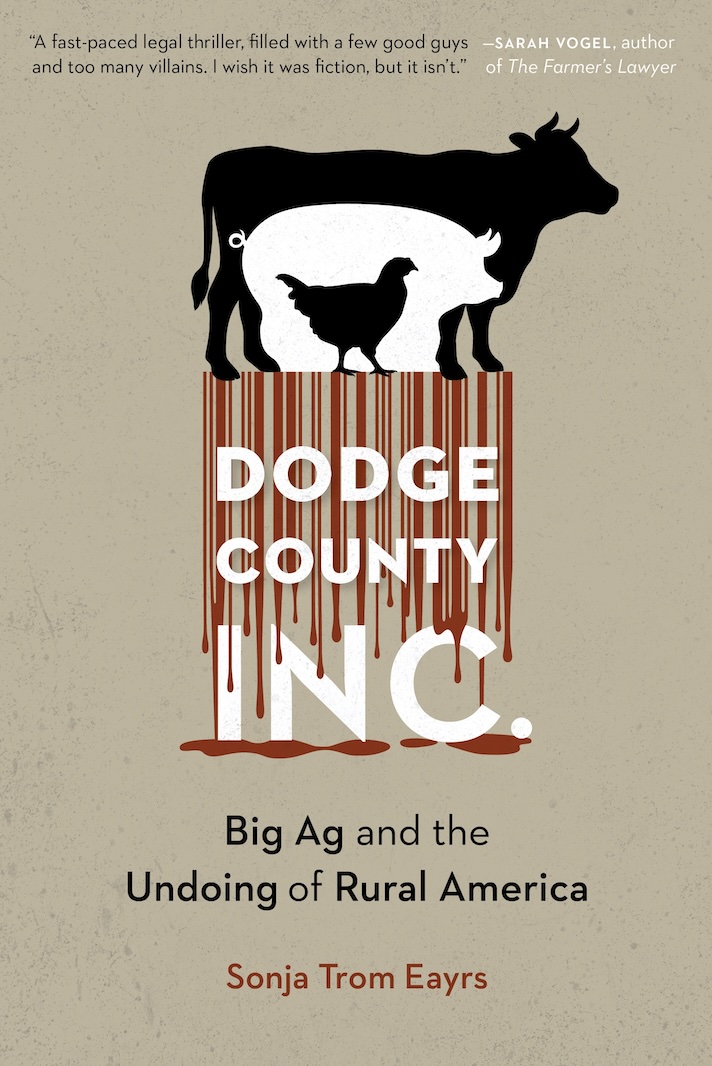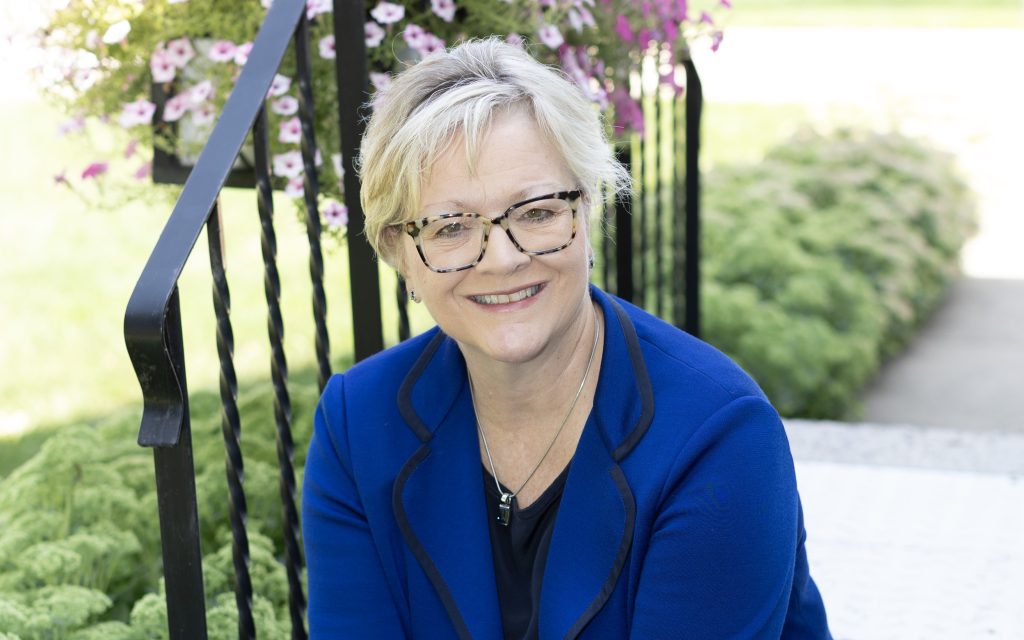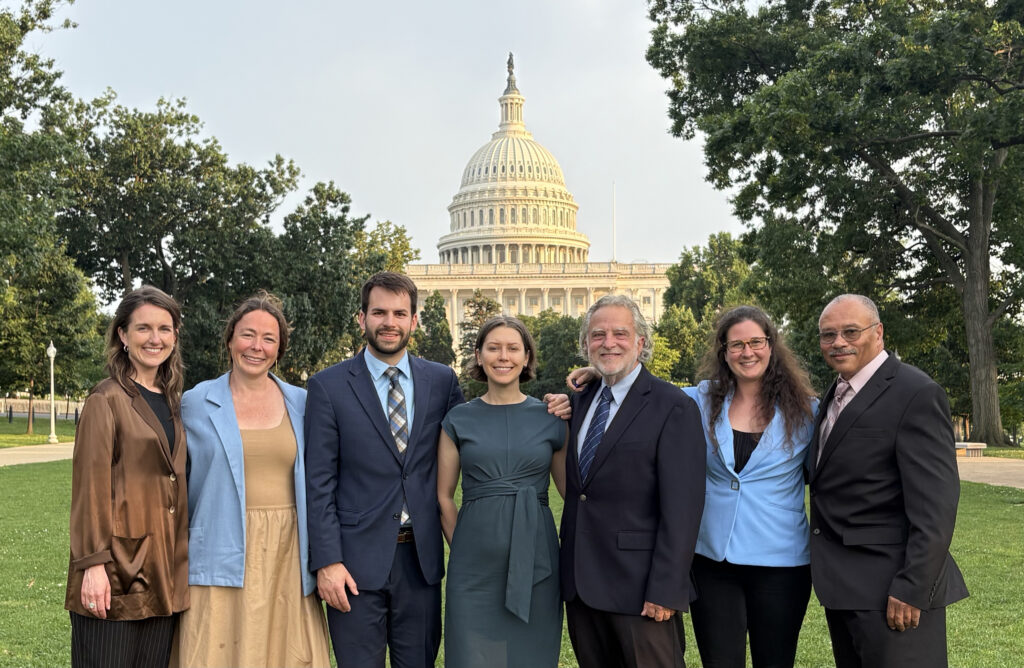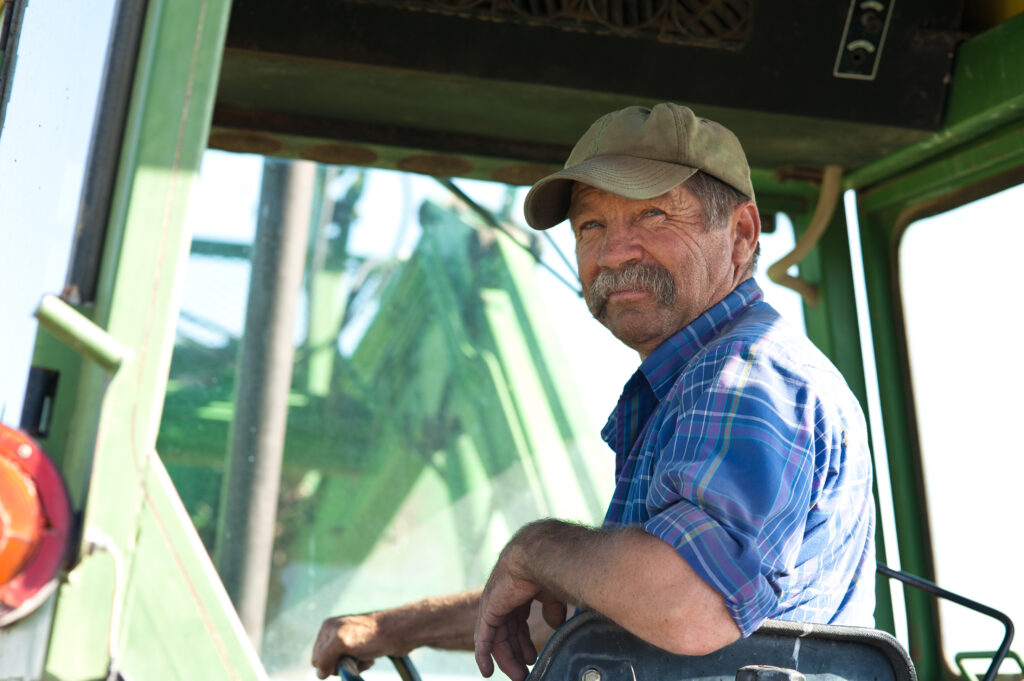Sonja Trom Eayrs grew up on her family’s 760-acre corn and soybean farm in rural Minnesota, where among her favorite things to do were riding in the combine with her dad or biking down quiet country roads. The best parts of her childhood could not occur today without the overwhelming stench of manure from nearby industrial farms or semi trucks flying by on the ill-equipped rural roads. Sonja’s home community has turned into an unrecognizable place — the Trom family farm is now surrounded by 12 swine Confined Animal Feeding Operations (CAFOs) within a 3-mile radius. CAFOs and their corporate sponsors have divided the community, driven independent farmers out of business, and harassed people like the Trom family who speak out against corporate agriculture. As she’s quick to note, Sonja’s story isn’t uncommon. It’s a reality that has been unfolding for decades in rural communities nationwide.
Sonja’s upcoming book, Dodge County, Incorporated: Big Ag and the Undoing of Rural America, documents her family’s decades-long fight against industrial agriculture. The Trom family has had front-row seats to the devastating impacts that industrial farms have on rural America. Sonja spoke with Farm Action about her book, which will be released on November 1.
To learn more about the book or contact Sonja, visit her website.
This interview has been condensed and edited for clarity.
When did you and your family first start seeing CAFOs creep into your hometown? And what did the rise of industrial agriculture mean for small and mid-size producers in the area?
More than 30 years ago, the son of a Farm Bureau farmer installed the first swine CAFO one mile north of our farm in 1993. The industrial system directly impacted independent hog farmers like my sister Shelley and her husband, Dave. They farmed outside our hometown, Blooming Prairie, Minnesota. They raised corn and soybeans, and Dave also raised hogs. Dave and Shelley had their own hogs and bought and sold hogs on the open market.
They had a smaller operation, but Dave noticed that it was becoming more and more difficult to deliver their hogs to Hormel in nearby Austin, Minnesota. Hormel was rushing large semis full of pigs from area CAFOs through the plant, while independents like Dave had to wait 45 minutes to an hour to deliver hogs to market. Independents, like Dave, were slowly and methodically denied access to the marketplace, while CAFO operators were given priority at the point of delivery.
The breaking point for independent farmers occurred in 1998. Prices dropped to eight and nine cents per pound. Farm Credit Services sponsored a meeting and invited several farmers, including Dave and Shelley. They, along with other small to midsize farmers, were told that there was funding available for them if they were willing to scale up and grow for nearby integrators on a contract basis. Dave and Shelley could no longer find financing for their operation, and they were also not willing to take on the debt to scale up, so they were forced to get out of farming altogether. Industrial farm operators expanded their operations, while independents were forced out of business.
What are the impacts of being surrounded by CAFOs?
The impacts are far-reaching. The stench of manure from these farms is so intense that no one can go outside during the pump-out of these large industrial facilities. It’s inhibited family farms and homes from serving as gathering spaces. It’s hollowing out communities. When the animals left the land, the people followed. It’s deteriorated rural roads that were not built to withstand commercial activity. And, generally, it’s just changed the entire character of small towns.

Local ordinances have been modified to accommodate industrial agriculture. In Dodge County, for example, local ordinances have been modified to accommodate large industrial operations and “manure acres” while limiting residents from living in the agricultural district and stifling other types of development. Agricultural districts have been turned into industrial zones of commercial activity.
Corporate agriculture has negatively impacted the comradery in the local community. I used to babysit and go to church with people who are now on the opposite side of this issue. It’s divided us.
How has your community responded to the influx of CAFOs?
The rollout of industrial farming was very subtle at first, and rural residents really had no idea what was happening and the significance of this change to the rural landscape. But today, citizens understand the dramatic changes that have occurred in rural areas and line up on one side or the other of this divisive issue, or they don’t say anything at all.
What we’ve learned over the past several years is people are silent for a few reasons. First, some people just don’t understand. Second, people are understandably afraid to speak out because their jobs are threatened, their businesses are threatened, or they have been threatened personally.
I’m in a unique position because I am an attorney and am frequently in the courtroom, and I’m not afraid of conflict. I don’t live on our farm, so I’m in a position to speak out, and it is vital that I do so.
What kind of backlash has your family faced as a result of you all taking action against these CAFOs?
As soon as my elderly parents filed their first lawsuit in May of 2014, the garbage started. Loads of garbage were dumped in our ditches -– just the beginning of the harassment and intimidation. My elderly parents filed three lawsuits against Dodge County officials and area CAFOs.
My dad received phone calls in the middle of the night asking if he’d changed his mind yet. In one instance, someone scattered blue booties worn in CAFOs all the way leading up to our driveway, just a reminder that the industry boys are large and in charge. Just a few hours after my brother and I pulled weeds from the field, the stop sign just yards away was sprayed with bullets. A manure tanker tried to run our vehicle off the road.
But it doesn’t end there. I have been the target of at least four false telephone calls to the local Sheriff’s Department, not to report some infraction but to put the heat on me and get me to shut up. Area factory farm operators utilize the sheriff’s department as their personal security.
We are not alone in what we have faced. I have heard from people across the country who have faced similar abuse and harassment for speaking out against Big Ag in their area, and I discuss those at length in my book.
Who is to blame?
I lay blame for the tragic situation in rural America today upon the multinational giants, easy money, poor federal policy, and lack of antitrust enforcement, which has placed profit before people. There’s been a secret corporate agenda in rural America for years, and people are just now starting to pay attention. I believe politicians at every level bear some responsibility for a lot of what has occurred in rural America and the hollowing-out of these communities in the pursuit of advancing and promoting corporate agriculture.
As I write in the book’s introduction, “We don’t need to organize our economy, our communities, and our agricultural practices around the profiteering of Hormel, Cargill, Smithfield, Tyson, and other multinational giants. We must instead reclaim and celebrate what many generations of farmers embraced: nurturing the land and the animals, maintaining a sustainable food supply, promoting public health, valuing clean air and the opportunity to swim and fish in healthy local streams and lakes, and cherishing nearby neighbors and friends. In failing to align with these values, large corporate interests continue to create conflicts in rural areas, conflicts that then reverberate in American cities and towns.”
What do you hope people take away from your book?
The more outspoken I have become on this topic, the more phone calls I receive from people in other rural areas who are going through the same situation. No one knows where to turn for help. Residents typically receive notice just a few days before a new CAFO breaks ground in their area.
My hope is to not only educate people but also inspire them to take action. That could be as simple as making better consumer choices, but it’s also more than that — we need to take political action. Corporate domination is happening in so many industries, and I think that is finally coming to light on a broader scale.
While this fight leaves many people feeling powerless, the people have power if we join together. At the end of the day, this is a community versus corporation fight.
Visit Sonja’s website to learn more about the book and where to purchase it.
Written and edited by: Emma Nicolas, Sonja Trom Eayrs, and Jessica Cusworth.




